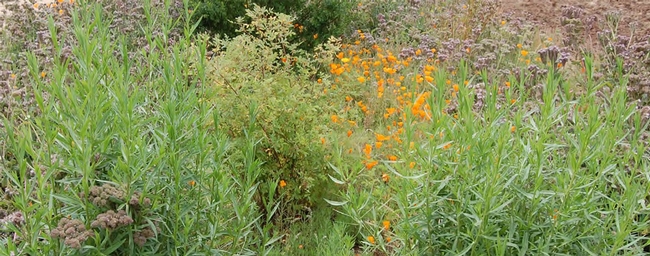By Brent McGhie, Butte County Master Gardener, December 9, 2016.

While farmers have historically planted hedgerows around fields to delineate boundaries, provide windbreaks and keep livestock from wandering, University of California research shows that hedgerows also provide many unintended benefits. Hedgerows have significantly fewer crop pests and more beneficial insects, such as pollinators and predatory wasps, than conventional field edges and these benefits extend into adjacent croplands. Hedgerows also provide habitat for insect-eating birds and other wildlife. Native bees benefit from the undisturbed habitat, as well as the nectar and pollen that hedgerows can provide. Additionally, hedgerows are useful in controlling dust, reducing sound pollution, and preventing erosion.

Urban and suburban landowners can reap these benefits by planting smaller trees and large shrubs to establish mini-hedgerows instead of fences or hedges. A scaled-down hedgerow will still attract pollinators, beneficial insects and birds. Hedgerows can also create corridors between wild spaces, allowing wildlife to more safely move through neighborhoods. As landscape designer Rebecca Lindenmeyr says, “Hedgerows can provide a slice of wild on the outskirts of a landscape design.”
If you decide to create a hedgerow, try to choose plants with a variety of heights. Different types of wildlife are adapted to living at different levels above the ground. Also, generally speaking, wider is better when it comes to hedgerows. The wider the planting area, the more room there is for a greater diversity of plants. The greater the diversity of plants in a hedgerow, the more likely it is that wildlife will find a suitable habitat there. Look for plants that provide food for wildlife. Selecting a variety plants that produce flowers, fruit, nuts, seeds, or nectar at different times of the year increases your chances of providing food for the greatest diversity of wildlife species.
Native plants are a logical choice for use in hedgerows. They are familiar sources of food and shelter for local wildlife species, and are well adapted to the local climate and soils. Large native shrubs that are suitable for residential hedgerows in our area include California redbud, toyon, many species of Ceanothus and manzanita, coffeeberry, desert willow and coyote brush. California bush anemone, Cleveland and white sage and buckwheat are more moderately-sized natives that can also be useful in hedgerows. Smaller native perennials include deer grass, California fuchsia, milkweed and penstemon. An added bonus is that, once established, all of these natives are at least moderately “deer resistant.” It is important to recognize, however, that if they are hungry enough deer will eat virtually anything.
Three larger nonnative plants that deserve consideration for incorporation into hedgerows are rosemary, Chinese fringe flower and chaste tree. All are adapted to our climate, deer resistant, and relatively easy to manage. If you'd like to see what these plants look like in a garden setting, the chaste tree and most of the native plants mentioned above can be seen in the Demonstration Garden being developed by Butte County Master Gardeners at the Patrick Ranch Museum. Whatever plants you decide to use, enjoy the natural beauty and other benefits of your hedgerow!
For further information on residential hedgerows, consult the following sources for this article:
Butte Co. Master Gardeners. "Make Room for Hedgerows!" Butte County Gardening Guide and Three-Year Gardening Journal (2015): 104 (with thanks to Eve Werner).
